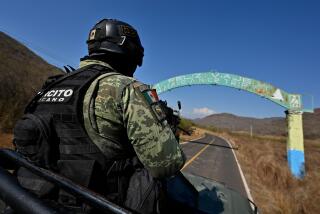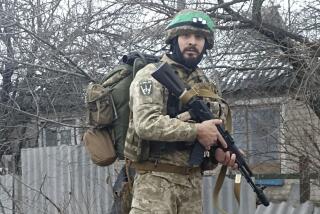Cut in Spy Flights Hurts U.S. Drug Fight
WASHINGTON — A key element of the drug war in Colombia is faltering because U.S. surveillance flights over major cocaine-producing regions have declined by two-thirds over the past year, according to administration officials.
The near disappearance of U.S. radar planes severely erodes the ability of U.S. forces to spot smugglers flying low over the jungle and to direct intercept missions by South American warplanes.
In Peru, those intercepts proved highly successful, helping drive down Peruvian coca production by two-thirds between 1995 and 1999, according to Barry R. McCaffrey, director of the Office of National Drug Control Policy.
For want of such simple equipment as firetrucks and navigational beacons, the drug battle has barely gotten underway over an area of southwestern Colombia, which took up the slack from Peru. Colombia doubled its coca production during the same 1995-99 period to an estimated 520 tons last year, twice the U.S. annual consumption. That burgeoning cocaine trade finances an anti-government insurgency.
Moreover, in Peru, drug traffickers are resurgent because of the decline in surveillance and interdiction, U.S. and Latin American officials said.
That decline is the result of diplomatic setbacks, friction between Congress and the Clinton administration, Pentagon infighting and the competing demands of other military operations, the officials said.
Restoring aerial surveillance is “absolutely critical” to U.S. anti-drug initiatives in South America, Marine Gen. Charles E. Wilhelm, commander-in-chief of the U.S. Southern Command, recently told Congress. “I am in urgent need of help on the intelligence, surveillance and reconnaissance side.”
Wilhelm said he had reduced the Southern Command to the lowest readiness status for those functions, meaning that it could not be expected to carry out its assigned missions.
The $1.6-billion package of counter-narcotics aid for Colombia working its way though Congress includes only minor provisions to boost surveillance flights and does nothing to deliver what Wilhelm says he needs most: E-3 AWACS, the Air Force’s largest and most sophisticated radar plane. “Those are the long-reach, long-look airplanes that we need to do the job in the deep source zone,” Wilhelm said.
The nation’s 30 AWACS are in such heavy demand elsewhere that none are permanently assigned to the Southern Command and temporary tours have become increasingly rare since the air campaign in Kosovo last spring.
“We are just way too stretched out between the Balkans, Iraq and North Korea to commit these assets to drug interdiction in South America,” said a senior Air Force official.
Concerned that the Pentagon underestimates the importance of the drug war, McCaffrey wrote Defense Secretary William S. Cohen last month warning that weakened capabilities in Latin America could jeopardize the Colombia effort. The retired army general asked for a commitment to rebuild surveillance capacities, senior officials said.
While declining to discuss the letter, McCaffrey said in an interview that “our ability to get into the Andean ridge has dwindled to about zero.” The White House drug official said he had made it known throughout the administration that “I think we have to get going on this, and if we don’t, we face a potential disaster within three or four years.”
Surveillance flights are essential “because we can’t go in there and fight this ourselves,” a senior administration official said. “The best thing we can give these countries is good intelligence about the source zones so they can get in there and do it themselves, but since last May, that has not been possible.”
Last May, U.S. military forces and law enforcement agencies abandoned Howard Air Base in Panama and lost the use of the long runways and first-class maintenance and supply facilities that for decades had supported U.S. air operations throughout Latin America and the Caribbean. Recognizing its importance to counter-narcotic efforts, the Panamanian government initially indicated a willingness to let Howard continue operating after other U.S. installations were closed when the United States ceded control of the Panama Canal. But early last year, the Panamanians unexpectedly insisted that U.S. forces leave Howard.
More than 2,000 flights a year had been taking off from Howard on drug-related missions, including surveillance flights that allowed Peruvian authorities to target coca fields for eradication and to intercept airplanes carrying cocaine from production labs to embarkation points for shipment to the United States.
Just as the United States planned to shift the surveillance strategy from Peru to Colombia, it found itself obliged to seek a replacement for Howard. Southern Command and the State Department tried to fill the gap by borrowing space at several airfields.
In recent months, Customs Service radar planes and Air National Guard F-16s have flown out of airports on Curacao and Aruba, two islands in the southern Antilles, to track smugglers crossing the Caribbean in boats or airplanes.
Surveillance of the cocaine-producing regions in Colombia, Peru and Bolivia was to be based out of a military airfield in Manta, Ecuador--a Pacific port roughly midway between the coca-growing regions in Colombia and Peru.
“From Manta and only from Manta can we reach down and cover the deep southern portion of the source zone,” said Wilhelm, promoting the Colombia aid package on Capitol Hill.
But the airfield, which had been a training base for Ecuadorean military helicopter pilots, lacked even basic maintenance, storage, safety and navigational facilities and the runway was in disrepair and too short for big jets such as AWACS.
Republican leaders in Congress last year refused to authorize funding for initial improvements at Manta, arguing the Clinton administration had mishandled the negotiations for Howard and failed to secure a long-term agreement with Ecuador for use of Manta.
More to Read
Sign up for Essential California
The most important California stories and recommendations in your inbox every morning.
You may occasionally receive promotional content from the Los Angeles Times.










